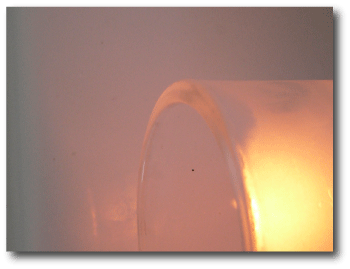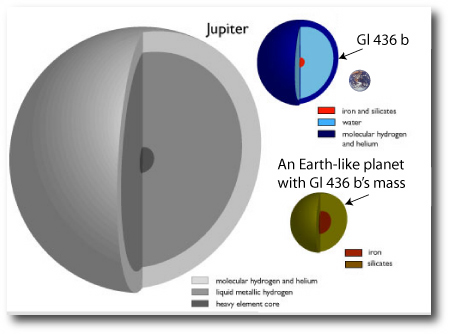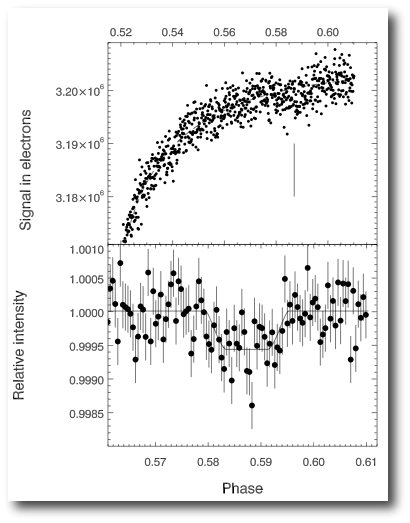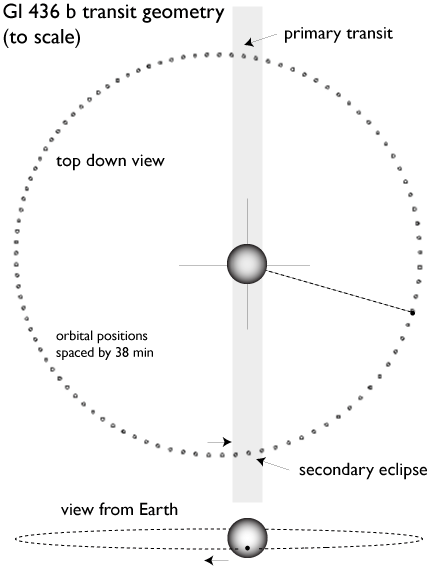
Image Source.
Regular oklo readers will recall Gillon et al.’s discovery that the Neptune-mass planet orbiting the red dwarf star Gl 436 can be observed in transit. Transitsearch got scooped, and the whole eposide got me all worked up enough to neglect the exigencies of everyday academic life and reel off three straight posts on the detection and its consequences (see here, here, here, and also here). The transits of Gl 436 b are a big deal because they indicate that the planet is possibly composed largely of water. It’s not a bare rock and it’s not a Jupiter-like gas giant. Rather, it’s consistent with being a fully Neptune-like object, hauled in for inspection on a 2.64385 day orbit.

Following Gillon et al.’s announcement, it became clear that Gl 436 transits would fit into a window of observability during the June 24th – July 04 IRAC campaign on the Spitzer Space Telescope. The red dwarf parent star, furthermore, because of its proximity, is bright enough for Spitzer to achieve good photometric signal-to-noise at 8-microns. As a result, Joe Harrington’s Spitzer Target of Opportunity GO-4 proposal was triggered, and the Deep Space Network radioed instructions to the spacecraft to observe the primary transit on June 29th, as well as the secondary eclipse (when the planet passes behind the star) on June 30th, a bit more than half an orbit later. Joe, along with his students Sarah Navarro and William Bowman, and collaborators Drake Deming, Sara Seager, and Karen Horning asked me if I wanted to participate in the analysis. After watching all the ‘436 action from the sidelines in May, I was more than happy to sign up!
One of the most exciting aspects of being a scientist is the round-the-clock push to get a time-sensitive result in shape for publication. There’s a fantastic sense of camaraderie as e-mails, calculations, figures and drafts fly back and forth. On Monday afternoon PDT (shortly after midnight GMT) when Mike Valdez sent out his daily astro-ph summary, it was suddenly clear that we were under tremendous pressure to get our results analyzed and submitted. The Geneva team had swooped in and downloaded the data for the primary transit the moment it was released to the community! They had cranked out a reduction, an analysis, and a paper, all within 48 hours. Their light curve confirmed the ground-based observations. Spitzer’s high-quality photometry indicates that the planet is slightly larger than had been indicated by the ground-based transit observations. Drake submitted our paper yesterday afternoon.
Fortunately for us, the real prize from Spitzer is the secondary eclipse. Its timing is capable of independently confirming that the orbit is eccentric, and the depth gives an indication of the surface temperature on the planet itself.
The upper panel of the following figure shows the raw Spitzer photometry during the secondary eclipse window. IRAC photometry at 8 μm is known to exhibit a gradually increasing ramp-up in sensitivity, due to filling of charge traps in the detectors, but even before this effect is modeled and subtracted, the secondary transit is visible to the eye. The bottom panel shows the secondary transit in detail.

The secondary transit occurs 58.7% of an orbit later than the primary transit, which proves that the orbit is eccentric. A detailed fit to the transit times and to the radial velocities indicates that the orbital eccentricity is e=0.15 — halfway between that of Mars (e=0.1) and Mercury (e=0.2). The orbital geometry can be drawn to scale in a diagram that’s 440 pixels across:

The depth of the secondary eclipse is 0.057%, which allowed us to estimate a 712 ± 36K temperature for the planetary surface.
A temperature of 700+ K is hotter than expected. If we assume that the planet absorbs all the energy that it gets from the star and re-radiates its heat uniformly from the entire planetary surface, then the temperature should be T = 642 K. The higher temperature implied by the secondary eclipse depth could arise from inefficient transport of heat to the night side of the planet, from a non-“blackbody” planetary emission spectrum, from tidal heating, or from a combination of the three. If the excess heat is all coming from tidal dissipation, then the Q-value for the planet is 7000, suggesting that it’s a bit more dissipative inside than Uranus and Neptune.
What would Gl 436 b look like if we could go there? To dark adapted eyes, the night side is just barely hot enough to produce a faint reddish glow (as is the case on the surface of Venus, which has a similar temperature). The atmosphere is too hot for water clouds, and is likely transparent down to a fairly high atmospheric pressure level. The day-side probably reflects a #E0B0FF-colored hue that contrasts with the orange-yellow light of the star. The planet spins with a period of 2.32 days so that it can be as spin-synchronous as possible during the sector of its orbit closest to periastron. At a fixed longitude on the planet, the day drags on for 456 hours from high noon to high noon.
Jonathan Langton has been running atmospheric simulations with the latest parameters. On the phone, just a bit ago, he would only say that the preliminary results were “interesting”…

I’m intrigued. Why would the day-side sky seem Mauve ? what atmospheric constituents would you expect ?
I presume that you’re extrapolating the color from the spectra, but do you have any ideas what dust, etc. hazes would cause it?
Gl 436b is very good candidate for transit parallax multiple spacecraft observation (see: SCHARF C.,2007
Exoplanet Transit Parallax, ApJ. , 661 , 1218 or http://arxiv.org/abs/astro-ph/0702749v1).
There are quite few spacecrafts capable of such photometry, like Spitzer, Rosetta, Deep Impact- EPOCh, Cassini etc.
Nikki
Hi mckinstry,
I’m extrapolating down in temperature from the HD 209458b models of Jonathan Fortney and collaborators. The idea is that you have selective absorbtion of red by molecules in the largely cloud-free atmosphere accompanied by Raleigh scattering which preferentially sends back the blue light from the star to the observer. Check out this oklo post from last year:
http://oklo.org/?p=96
John Moores created Fortney’s optical spectrum in an integrating sphere, and it appears quite close to Mauve.
best,
Greg
Hi, I did a simulation of Rayleigh scattering with various blackbody spectra (basically multiplied the blackbody spectrum by 1/lambda^4), then integrated the resultant spectrum. Result I got for illumination by a ~3500 K red dwarf is very pale blue, not mauve.
Perhaps for hotter planets (like HD 209458 described in the post you linked), the red glow from the planet becomes more important and starts tinting it mauve, I’m not sure…
Hi andy,
Interesting. Could you take a screenshot of the resulting color or send a link?
Greg
Colour I get for Rayleigh scattering of a 3500 K blackbody is #D9EDFF. If you like, I could send you the Perl script I used to generate it.
It would be nice to have the perl script.
For those following the discussion, here’s #D9EDFF:
Doesn’t quite have Mauve’s decade-nostalgia panache, but I think Oscar Wilde would likely have approved of D9EDFF as well.
Out of curiosity, how does that color compare to the day-side sky of earth?
It’s rather pale isn’t it. In fact, I’m seeing a rather good approximation to that colour looking out of my window at a dismally overcast sky.
My script generates an RGB colour of #3A78FF for Rayleigh scattering around a Sunlike star, which if you check it is a much deeper and bluer shade.
So maybe a clear sunny day on a habitable planet orbiting a red dwarf looks a bit gray and grim.
The HAT team just got an accepted paper in ApJ Letters. Looks like they have an interesting , metal-rich hot-Jupiter around a K-dwarf. No preprint yet :(
A web search got this:
HAT-P-3b: A Transiting Planet with a Rocky Core. Rp = 0.89 +/- 0.05 RJup. Mp = 0.61 +/- 0.03 MJup. r = 1.1 +/- 0.2 g cm-3
from a presentation by Charbonneau.
Looks very interesting. Any more info on this anyone ? Identity of the star ?
Cheers,
Luis
A brief update from COROT:
“A complete set of twelve thousand exoplanet lights curves, corresponding to one month of observation, has already been generated.”
http://smsc.cnes.fr/COROT/GP_actualite.htm
Mmmm, light curves.
Pingback: systemic - 6 Gigabytes. Two Stars. One Planet.